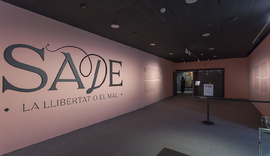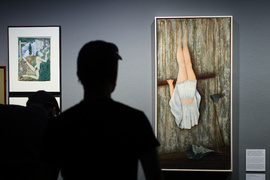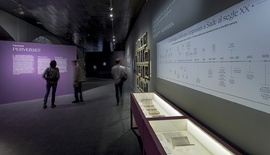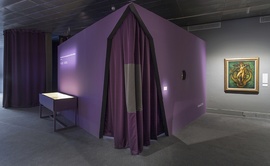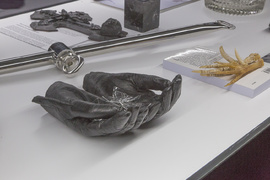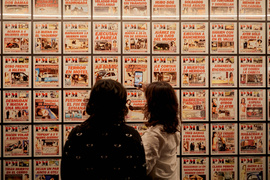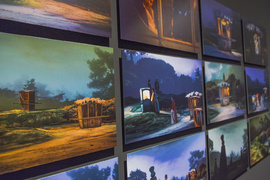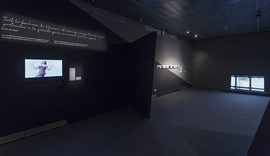Exhibition
Sade
Freedom or evil
An exhibition that explores the aesthetic, philosophical and political legacy of the Marquis de Sade in contemporary culture, from the early 20th-century avant-gardes to the present day.
The libertine writer Donatien Alphonse François de Sade (1740-1814) is a controversial figure, regarded by some as a revolutionary, liberating thinker, and by others as a pernicious and corrupting writer. His writings can be interpreted as a philosophy of freedom but also as a philosophy of evil.
The exhibition presents the figure of the Marquis de Sade and the influence that his legacy has had in the realm of thinking from the early 20th century up until the present day. It presents the impact that his controversial texts have had on a series of artists and intellectuals, and explains how he has become a very present icon in mass culture. In the 20th century, numerous works referring to him directly or indirectly were created, which can be seen as a sign of the fascination, uneasiness and contradictions that his ideas provoked last century, as well as proof of the subversive potential of his literary production that still resonates today.
“Sade. Freedom or Evil” is an invitation to revise stereotypes like the ones associated with the term sadism, and to reflect on how Sade can prompt shock and scandal on the one hand, and be hailed as the personification of revolution on the other. The exhibition addresses this analysis by looking at fundamental avant-garde figures who have celebrated the author: Guillaume Apollinaire, Georges Bataille, Salvador Dalí, Toyen and Man Ray, among others. It also presents the critical vision of Pier Paolo Pasolini and the reflections of contemporary artists who explore freedom of expression, the transmutation of gender roles, desire, violence, the institutionalization of terror and the role of pornographic imagination in consumer society.
The exhibition comprises documentation of the historical performances of Jean Benoît and Jean-Jacques Lebel, photography projects by Marcelo Brodsky, Robert Mapplethorpe, Pierre Molinier and Susan Meiselas, and references to works of literature, cinema and comic books, along with videos of interviews with philosophers and researchers. Installations by artists such as Laia Abril, Paul Chan, Shu Lea Cheang, Teresa Margolles, Joan Morey and Kara Walker take their place alongside new productions by Joan Fontcuberta and Domestic Data Streamers, with references to the works for stage of Angélica Liddell, Albert Serra and Candela Capitán, and the filming of an excerpt from Le retour de Sade, by Bernard Noël, directed by Guillem Sánchez Garcia and featuring Clàudia Abellán and Joel Cojal.
Sections of the exhibition
The visit to the exhibition begins with a prologue dedicated to Sade’s life, continues with four thematic areas about his cultural and philosophical legacy, and ends with an epilogue about his theatrical vocation. The four central spaces of the exhibition are called “passions”, a term taken from The 120 Days of Sodom. In the course of the show, visitors will encounter Transgressive Passions, addressing Sade’s influence on 20th-century avant-gardes, Perverse Passions, dealing with the limits of the representation of eroticism, Criminal Passions, exploring abuse, cruelty and domination, and Political Passions, a section that addresses systemic violence and the abuse of power. Should Sade’s work be considered a philosophy of freedom or evil? The exhibition raises this question, which suggests that they could be inseparable: without thinking about evil, it is difficult to define freedom.
To find out more about the sections of the exhibition, click on More information.
The Improper, a space for meeting, talking and reading
In the foyer of the exhibition “Sade. Freedom or Evil” you’ll find The Improper, a freely accessible space with a small library on dissident sexualities that also hosts meetings, conversations and workshops on the subject.
Curators: Alyce Mahon, Antonio Monegal
Sections of the exhibition
Prologue: Sade and his philosophy in the boudoir
The life of the Marquis de Sade was full of excesses and contradictions. He was persecuted for his sexual tendencies, his political and moral stances, and his writings. He spent 27 years in prison and ended his career putting on plays at the Charenton asylum. He aspired to be recognized as a man of letters, but some of his extensive body of work was lost. The 20th century saw a veritable cult of Sade when his works were reprinted. Today, new generations of writers and artists are embracing his transgressive philosophy and revolutionary message.
With works by Joan Fontcuberta and Paul Chan, first editions of books by Sade and excerpts from Salò by Pier Paolo Pasolini.
Transgressive passions
The 20th-century avant-gardes saw in Sade a spokesman for freedom. The surrealists recognized him as a precursor, and a long list of artists illustrated or invoked his work. After World War II, Sade’s legacy acquired a philosophical dimension, and the challenge since then has been how to interpret his legacy: as a model of transgression and sovereignty, or as an example of the dangers of pure rationality and absolute freedom. In the sixties, reinterpretations were made of his writing, and revolutionary Sade was also linked with May 68.
With works by Salvador Dalí, Otto Dix, Luis Buñuel, Alberto Giacometti and Roberto Matta, books illustrated by Leonor Fini, Toyen, André Masson and Hans Bellmer, and photographic documentation of a performance by Jean-Jacques Lebel.
Perverse passions
The latter half of the 20th century popularized the figure of Sade. Starting in the late 1960s, with the liberalization of sexuality, he emerged as an icon in mass and underground culture, though without losing the disturbing edge that caused scandal, censorship or intolerance. Sade’s influence is associated with social acceptance of consensual non-normative sexual practices, traditionally considered perverted, and calls for the multiplicity of desire and the questioning of gender roles. On this scene of apparent tolerance, Sade’s radicalism retains its subversive capacity, picked up by artists and LGBT+ activists.
With works by Pierre Molinier, Susan Meiselas, Robert Mapplethorpe, Miguel Ángel Martín, Jan Švankmajer, Nobuyoshi Araki, Quimera Rosa, Joan Morey and Carles Santos.
Criminal passions
In the 19th century, Krafft-Ebing coined the term sadism, and Sade’s name has since been associated with abuse, cruelty and domination. Sade declared that he was neither a criminal nor a murderer, but his work forces us to confront the place of evil in both human experience and fantasy. In the face of multiple manifestations of horror, science has explored and developed hypotheses and experiments about what we call evil. The media gives us daily reports of gender violence, rape and child abuse, while the public displays a morbid appetite for the sensational.
With works by Sira-Zoé Schmid, Paul McCarthy, Laia Abril and Domestic Data Streamers, the experiments of Milgram at Yale and Zimbardo at Stanford, and excerpts from Funny Games by Michael Haneke.
Political passions
Sade is more present than ever in our culture, reflected in a value system typical of neoliberal logic. He reminds us that enlightened reason is the source of both human rights and their negation. The sadistic aspects of Nazism and other forms of oppression are widely discussed, but Sade opposed the violence of the French Revolution and the guillotine, and torture, plunder and extermination are sources of individual pleasure for his characters. Violence and abuse of power have a collective dimension in present-day society, and must be examined in the light of Sade’s ideas in an attempt to understand where they stem from. The idea is not to attribute all of humankind’s evils to Sade, but to read his writings as a challenge to be able to confront what evil means.
With works by Joan Fontcuberta, Teresa Margolles, Marcelo Brodsky, Kara Walker and Blalla Hallmann.
Epilogue: Staging revolution
Sade’s theatrical vocation accompanied him throughout his life, and he devoted himself to the theatre while he was committed in Charenton. By way of homage to his dedication, we bring together a series of creators and productions from the performing arts that echo his legacy. In the 21st century, Sade’s name and work continue to be invoked by postfeminism, queer theory, post-porn, theatre, cinema and contemporary art, which explore the limits of prohibition, claim the power of desire and imagination, and highlight the tension between Sade’s libertine ideas and the moral challenges they pose.
With an excerpt from Le retour de Sade by Bernard Noël and audiovisual footage and photographs of works by Albert Serra, Candela Capitán, Angélica Liddell and Shu Lea Cheang.
Related contents
Inés Martín Rodrigo & Mar García Puig
Words that lead the way
Writers Inés Martín Rodrigo and Mar García Puig talk about how to build new cultural references for sexual dissidence from the literary word.
Alyce Mahon and Antonio Monegal explain the importance of revisiting Sade today.
Inside the exhibition "Sade. Freedom or evil"
This conversation between CCCB exhibition curators Alyce Mahon and Antonio Monegal takes a further look into the life, works and ideas of the Marquis de Sade. Mahon and Monegal take us through the thesis and themes put forward by the exhibition and explain the importance of revisiting the figure ...

